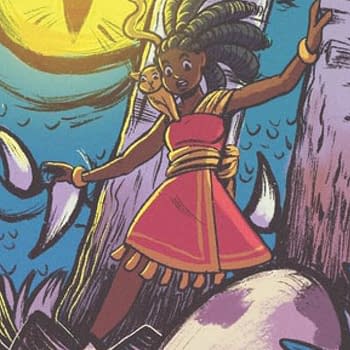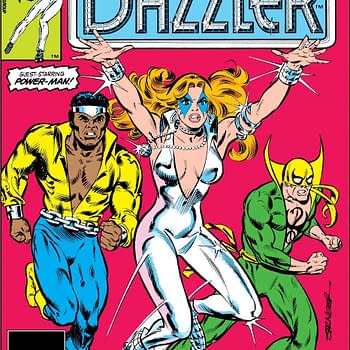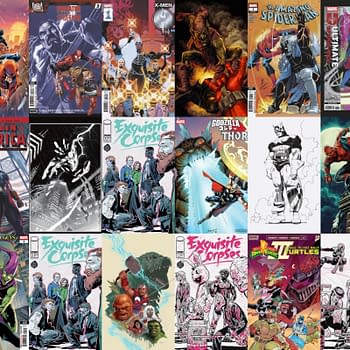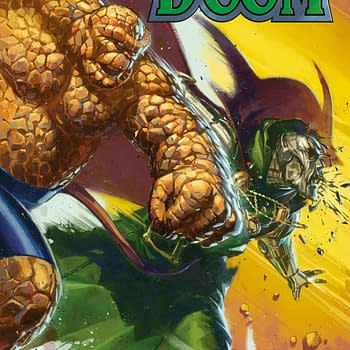Posted in: Comics, Recent Updates | Tagged: adam west, alex ross, batman 66, Comics, doctor doom, Eliot R. Brown, entertainment, gi joe, Jim Kreuger, kevin smith, my little pony, peter parker, philip k dick, robert kirkman, scott snyder, sean howe, steve gerber, thundercats, toys, wolverine
Four-Color Roots Part 1: The Toyetic Age (1985-1989)
By Christopher Smith
In the first installment of this ongoing column series, Christopher Smith takes us on a tour through his own back pages as a comics fan, going down unexpected dark alleys and diversions. Focusing only on the comics and pop-cultural touchstones he experienced at the time, he reconsiders their influence and impact from a modern-day context, and his own journey through the four-color and geek culture worlds that's apropos of so many comics creators of the same generation.
Batman is the character that grew up alongside me. In many ways, he was my favorite. As a kid, I loved him in Super Friends, when he guest starred alongside Scooby-Doo, and in other TV shows. Then as I got older, I discovered the comics…
– Scott Snyder, from the Foreword to Batman: The World of the Dark Knight (2012)
The first comic I remember reading – if I don't count a musty Mickey Mouse comic promoting energy conservation that sat, unwanted, in my grandparents' desk drawer – was Secret Wars #1. I'm not sure when it was, exactly. I think I might have been a bit older than the four-year-old I would have been when it came out. Perhaps it came in a value pack of other issues, bought by my dad for me at a corner gas station. Let's go with that. Then again, Clio, the muse of history, could be tricking me and it could turn out to have been Secret Wars II #1. Let's hope I never have the misfortune of discovering that.
I lay it on the floor of my parents' upstairs bedroom, in front of the same mammoth vacuum-tube TV on which I would watch G.I. Joe, Thundercats, and countless other B-grade cartoons, some of which we'll get to shortly. I spread the splash page open and this is what I saw:
Motes of dust danced in the cathode light between the set and my face, but I wasn't looking at them, as I often did. There before me were a host of characters, most of which I failed to recognize, some not. I surely knew Spider-Man from the syndicated reruns of the 1967 animated series, but it's not a show I have many memories of watching, aside from the opening/closing credits. It must have come on before or after a show that was the equivalent of appointment television for five-year-old me, or dimly attracted my awareness while I was velcroing on the overall straps of my Cabbage Patch Koosa doll.
Mostly, I was confused by the camera that Peter Parker pointed at the viewer, and its lens shutter. What was that, exactly? Similarly, I was a little perplexed by this double-page spread. I surely had encountered speech balloons before, but definitely couldn't make out much of this elaborate dialogue, at least half of which was dedicated to Reed Richards' attempt to explain the process of teleportation that brought the Marvel heroes to the Beyonder's homeworld. Lining up the dialogue bubbles and decoding the angsty poses of the page required solving a time-space equation of my own, for which I was unprepared. By the early 1990s, when my comic fandom began in earnest, I'd get no shortage of angsty poses (or splash pages, for that matter). But it would begin as more of a slow trickle, fueled by other forms of media. And, anyway, my mom wasn't too keen on my reading comics; she said they were beneath me…
In my childhood, I cut my teeth on superhero cartoons and toys, which came in two varieties: contemporaneous, and the syndicated leftovers of the previous two decades. I'm not the only one on whom they had a lasting influence. A generation of creative types, ranging from Kevin Smith and his cohorts to Scott Snyder, Geoff Johns, and Alex Ross – the latter two especially fond of recapturing the iconic and definitive takes on superheroes, despite varying levels of fan enthusiasm in response to their work – has spoken of the lasting influence of this simpler age of entertainment.
Often, it follows a certain arc. Adam West was this generation's Batman. The Superfriends were its introduction to the pantheon of DC heroes. Often, a Star Wars obsession shows up, the latter of which has fueled a great deal of inventive artwork in the footsteps of Ralph McQuarrie's innovative world-building concept art. The recent documentary, Bronies, features My Little Pony: Friendship is Magic mastermind Lauren Faust recounting her childhood My Little Pony obsession, which involved her acting out (often more adventure-inspired) scenarios with her toys, a creative re-imagining of the show's concept that bore the seeds of her later take on the franchise.
Of course, the toyetic – the industry term referring to concepts that are especially appealing as a merchandising concept – was, even in its era, not necessarily considered a good thing. For instance, a 1984 post on the early newsgroup net.comics reviled Secret Wars as 'designed to sell these cheap-o (I mean really cheaply made) toys to kids too young to know any better. This explains such momentous dialogue as "I, Crusher Creel, the Absorbin' Man, will…' that made me so disgusted I didn't even buy #1 (and boy, am I glad now!)." The Dr. Doom action figure that prompted such nausea, though, was a favorite of mine. So was his utterly superfluous Doom Cycle.
I collected enough proofs of purchase from DC's competitive, more comic-faithful Super Powers toyline to mail away for a Clark Kent action figure who wiggled his arms in a vaguely hurried motion when you squeezed his legs together. Inexplicably, he was one of my favorite toys. (Could it be that he reminded me of my dad?) As has been attributed to numerous sci-fi writers, the golden age of fandom is five. Whatever struck your young imagination at that time encodes the idea that your preferred form of escapism peaked then.
Why did Dr. Doom have newly designed cosmic armor, complete with an odd little plastic garter on one metallic leg? Perhaps for the same reason that the title of the comic and toyline was, as Sean Howe recounts in Marvel Comics: The Untold Story, named after a focus-group-chosen combination of the two words guaranteed to have the most appeal, logic be damned. (I've always found this factoid almost likened to William Burroughs' generative cut-up method of writing.) Batman action figures, in the wake of 1989-1992's Second Coming of Batmania, littered the store shelves in absurd variants of polar blues and solar reds and yellows. Something about this armor gripped my imagination; I wanted to know how it worked. Doom's true visage was fascinating – but then, I was used to masked bad guys who never showed their faces, like the equally toyetic Cobra Commander and even Dr. Claw on Inspector Gadget – but his technology, more so.
So I was delighted, years later, when I was first trawling back issue bins at conventions, to find 1984's Official Handbook of the Marvel Universe: Book of Weapons, Hardware, and Paraphernalia, Eliot R. Brown's detailed technical thesis on how, among other things, the Mandarin's rings and Wolverine's claws actually worked. That the handbook was lovingly pastiched, right down to font choice and page layout, by Robert Kirkman et al. for The Official Handbook of the Invincible Universe, is no real surprise. Kirkman himself belongs to this generation, and understands the appeal of a vast, exciting, confusing universe of characters, as his superhero work, full of cameos and running gags, illustrates. His mastery at building dense and involving worlds that hook you from one issue to the next shows that he internalized '80s Marvel and its strategies well.
Geoff Johns' skill at creating things like superfluous but fascinating parallel Lantern Corps, is straight out of the '80s animation playbook, and it's no wonder that he ended up working on DC's Masters of the Universe comic book, and even contributing the oddball action figure Sir Laser-Lot – created when he was eight! – to the recent Mattel reinvention of its toyline, and his comics work on the franchise.
Marvel/Sunbow Animation launched the ultra-toyetic 1982 incarnation of G.I. Joe as well, and legend of bizarre comics writing Steve Gerber served as a story editor on the series, contributing mind-bending episodes like "There's No Place Like Springfield," a two-parter in which Shipwreck finds himself inside a perfect but ultimately empty and disorienting fantasy world that's really a front for Cobra to extract military secrets from him. It's truly worthy of comparison with The Manchurian Candidate and Philip K. Dick, an episode of the series that definitely holds up to re-watching as an adult.
If Marvel offered its young readers the promise of a dazzling, strange world to get lost in, DC didn't quite do that. Rather, it offered something that already seemed comforting and familiar. One reason for this apparent dichotomy, though, is that DC's entertainment foothold at this time was more through syndicated shows a decade or more old. While Saturday mornings in 1985-1986 featured the Super Powers Team: Galactic Guardians TV series, today notable for giving Jack Kirby's Darkseid an early presence in TV animation, it still felt a little like a holdover from the simplified, everyone-gets-along blandness of the Silver Age, which is even more true of the various earlier incarnations of Superfriends, which featured utterly lysergic plots like Mr. Mxyzptlk turning the heroes into grotesque caricatures of Wizard of Oz characters. Its often cheap animation, stilted but utterly captivating voiceover narration, and naïve charm made the show a 1990s favorite, in its Cartoon Network promos featuring the team exchanging overdubbed "Wazzup?!" greetings, and Dave Chappelle being the first I recall to tell the "What's the deal with Aquaman" joke on Dr. Katz: Professional Therapist.
The show has since inspired a different kind of devotion, most notably Alex Ross and Jim Kreuger's 2005-2007 Justice comics series, which attempted a kind of epic-scale retelling of a match-up for the ages, done in Ross' love-it-or-hate-it glowing chiaroscuro style, suitable itself for a toyetic franchise of DC Direct collector action figures, and T-shirts. Before moving on, yes, the villains lived in a giant Darth Vader helmet in a swamp, and, yes, it made no narrative sense.
Last but not least was the 1966 Batman series, broadcast on a UHF Philadelphia station that I caught in the mid-1980s in suburban Delaware. This time, I was in my parents' basement, a stucco room with strange wooden fixtures that recalled a low-budget movie's depiction of a pirate tavern. I think I watched it on a black-and-white antenna TV, but the show's charm wasn't diluted by this substandard medium. It was 1967's "The Sport of Penguins" episode, which involved an elaborate scheme from that week's villain, a certain you-know-who, to switch racehorses and make off with untold amounts of loot. Mostly I remember it for learning that glue was made from horses; this utterly boggled my mind at the time.
I am, again, not sure how old I was. But I do know that, as Kevin Smith and many others have said, I was young enough to take it seriously, not to recognize the arch camp leanings, young enough to believe Batman and Robin walked up the sides of buildings on their slender Bat-Rope without any suspension of disbelief whatsoever. The urgency of the dashes to the Batpoles and the cleverness of the hidden entrance to the Batcave, from which the Batmobile sped each episode, these were viscerally exciting things. Even today, it's hard not to grow enamored of the show's frenetic pacing and madcap fight sequences.
Like Scott Snyder and others who were watching at the time, I was captivated, which only grew in the wake of 1989's Batman film. I didn't see that in the theaters (I'm thinking I was considered too young, and my parents more than dictated a lot of my entertainment choices at the time) but continued to watch those syndicated repeats, in color now, and started snapping up isolated bits of merchandise, most of which was on display at our local drugstore. By the end of the decade, a black-suited, suction-cup Batman clung to my bedroom window, watching over me as I played Nintendo, another pop-cultural touchstone I was relatively late to experience.
I had, of course, missed all of 1986's several shellshocks to comicdom, but would soon experience one of those in its collected form, on the unlikely place of my school bus. I would also, in two years, grow fascinated with a somewhat unlikely independent comics character to receive a film adaptation, and a Disney one at that. But first, I had to find the right ongoing monthly comic book on which to get hooked. To be, as they say, continued….
Christopher Smith teaches composition at Columbus State Community College and has spent about two thirds of his life being obsessed with comics, music, and the strange, somewhat overlooked corners of pop culture. He lives with his wife, son, and two devious cats.




















